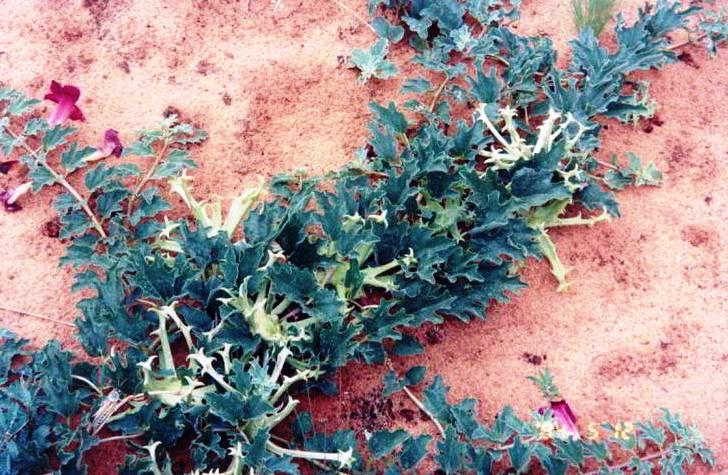It belongs to the Pedaliaceae plant family and is commonly referred to as devil’s claw, grapple plant, or wood spider.
It is a rare, highly valuable plant which is only found widely spread in the Kalahari Desert of Southern Africa especially in South Africa, Namibia, Botswana, Zambia, Zimbabwe, and Mozambique. Harpagophytum procumbens is a perennial ground herb which grows up to about 18 inches long with a stout central tap root which on average grows up to two meters deep.
Secondary storage tubers, which resemble an elongated sweet potato, branch off horizontally from the central tap root. Leaves are large, consisting of 3-5 lobes, and are covered in white mucilaginous cells, which makes them appear greyish-green in colour. Flowers are trumpet shaped and pink, red, or purple with a yellowish centre. The fruit grows from the flower and is woody, radiating numerous long barbed spines.
In fact, the name Devil’s Claw refers to the barbs on the fruits and the plant owes its scientific name, Harpagophytum, to this unique characteristic; fruit with a grappling hook, harpagos in Greek. The plant grows mainly in sandy soils particularly in open, trampled and over-grazed lands where grass and herb cover are low, but can also be found in dry savanna or open woodland.
Harpagophytum procumbens has been used in traditional medicine since time immemorial to treat a myriad of maladies including allergies, analgesia, anorexia, arteriosclerosis, boils, choleretic, dysmenorrhea, dyspepsia, edema, fever, fibromyalgia, fibrositis, gastrointestinal disorders, headache, heartburn, indigestion, liver and gall bladder tonic, malaria, migraines, myalgia, neuralgia, nicotine poisoning, sedative, skin ulcers, skin sores, tendonitis, urinary tract infections and wounds, among others.
It is the large, tuberous, succulent tap roots of Harpagophytum procumbens which are the major target in traditional medicine. This is due to the fact that they contain greater medicinal properties. The highly medicinal roots are cut into small pieces and dried immediately after harvesting to prevent them from deteriorating which unfortunately occurs within a short period of time after harvest. The dried root tubers are then ground to form powder, and to make tinctures, decoctions or infusions which are then administered in accordance to a given disease condition.
The traditional healers especially those from Southern Africa have used Harpagophytum procumbens for medicinal purpose for a very long time. They orally administer a strong decoction of Harpagophytum procumbens to enhance slow but steady relief of joint pain caused by both osteoarthritis and rheumatoid arthritis, including low-back pain and body inflammation. Additionally, the plant root also plays valuable roles in traditional medicine, where it is used as a digestive tonic and to treat blood disorders.
The decoction of the root is administered to relieve one from fever and allergies and is highly prescribed as an analgesic, including for the pain which is brought about by the process of childbirth. In addition, the pulverised root is used as an ointment for ulcers, boils and for difficult births. The dried root infusion is commonly used as a cure for digestive disorders including being used as a laxative and as an appetite stimulant. In some communities, the infusion of the root is orally administered to treat and manage diabetes.
However, caution is taken in this situation as the medication may at the same time raise the risk of one developing low blood sugar. The Harpagophytum procumbens root decoction has also been orally administered for liver and kidney disorders and as a purgative. The powdered root has been topically applied to treat wounds, as well as skin rashes.
Harpagophytum procumbens has an ancient history of multiple indigenous uses and is one of the most highly commercialized indigenous traditional medicines from Africa, with bulk exports mainly to Europe where it is made into a large number of health products such as teas, tablets, capsules, topical gels and patches. In fact, Harpagophytum procumbens is now widely used as herbal medicine in the West for its anti-inflammatory and analgesic properties.
The Harpagophytum procumbens tubers are an important source of income for many people living in and around the Kalahari Desert region. However, one of the main threats to Harpagophytum procumbens is over-harvesting for medicinal use.
Despite the fact that wild-harvesting of Harpagophytum procumbens tubers can be sustainable, the poor harvesting methods which in most cases involves digging out the whole root, coupled with intensive commercial use, can ultimately lead to the extinction of this valuable plant in the future.
Fortunately, Harpagophytum procumbens is currently classified as a protected species in Botswana, Namibia and South Africa. Permits are required for harvesting and exporting it. The Harpagophytum procumbens species has been listed under CITES in Annex D. Consequently, no part of the tubers or roots of the plant can be traded within the European Union without proper licenses.
However, more measures still need to be put in place so as to conserve this valuable medicinal plant for generations to come especially through the initiation and use of good harvest practices that can enhance the plant to regenerate after the first harvest. (Richard Komakech) – (Photo: © CITES Secretariat/Henri pidoux)







